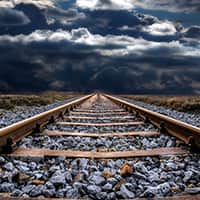The Construction of the Transcontinental Railroad
Written by Staff Writer

In 1862, the United States set out to achieve one of its greatest engineering feats: building a railroad that would stretch across the entire country, connecting the East Coast to the West. The Central Pacific Railroad began its work in Sacramento, California, while the Union Pacific Railroad started in Omaha, Nebraska.
Over the next seven years, these two companies faced harsh landscapes, unpredictable weather and immense challenges as they laid down miles of track. Their hard work paid off on May 10, 1869, when the two rail lines finally met at Promontory, Utah, marking a historic moment that forever changed travel, trade and life in America.
The Vision of a Nation-Spanning Railroad
The journey toward a transcontinental railroad began in 1830 with the debut of America's first steam locomotive, which spurred a rapid expansion of railroads across the East Coast. About 9,000 miles of track had been laid east of the Missouri River by 1850, but as settlers moved westward, driven by events like the California Gold Rush of 1848, the need for a coast-to-coast railway became clear.
Treacherous overland routes and perilous sea voyages made the vision of a faster, safer connection across the country a national priority. Efforts to realize this dream gained momentum in the 1840s with the proposals of an entrepreneur named Asa Whitney and in 1860, engineer Theodore Judah identified the Sierra Nevada's Donner Pass as a key route.
With the Pacific Railroad Act signed into law by President Abraham Lincoln in 1862, the ambitious project to connect the East and West officially began, laying the foundation for a new era of travel and commerce.
The Rivalry That Built the Transcontinental Railroad
The construction of the transcontinental railroad was framed as a race between two companies: the Central Pacific Railroad, building eastward from Sacramento and the Union Pacific Railroad, building westward from the Missouri River. Each company was incentivized with significant government bonds for every completed mile of track, fueling fierce competition.
The Central Pacific was led by the "Big Four" entrepreneurs, namely Collis Huntington, Charles Crocker, Mark Hopkins and Leland Stanford, who, despite their lack of railroad experience, pushed the project forward with aggressive financing and legal maneuvering. In contrast, the Union Pacific, controlled by Dr. Thomas Durant, was defined by financial schemes, which ensured profits for investors while delaying progress until the Civil War ended in 1865. Both companies faced setbacks, from leadership disputes to the untimely death of Central Pacific's visionary, Theodore Judah, in 1863, yet their rivalry drove them toward completing one of the most ambitious projects in American history.
Trials and Triumphs on the Path to Progress
The construction of the transcontinental railroad was fraught with danger, requiring tremendous perseverance from its workers and leaders. Under the leadership of Gen. Grenville Dodge, the Union Pacific began advancing westward in 1866, facing violent resistance from Native American tribes defending their lands.
Meanwhile, the Central Pacific grappled with the grueling task of carving a path from California through the Sierra Nevada, relying on the backbreaking labor of thousands of Chinese immigrants who endured hazardous conditions. Across the plains and mountains, temporary settlements arose, embodying the chaos and lawlessness of the "Wild West," while innovations in blasting techniques and trestle-building allowed progress to continue despite the obstacles. Through immense effort and sacrifice, the dream of linking the nation by rail began to take shape, though not without serious human and cultural costs.
The Race to the Finish Line
By 1867, the Union Pacific reached Wyoming after covering far more ground than its rival, the Central Pacific. However, after breaking through the Sierra Nevada, the Central Pacific finally gained momentum, and both companies raced toward Salt Lake City, cutting corners to claim more miles and government funding.
By early 1869, their tracks were only miles apart, prompting President Ulysses S. Grant to demand that they agree on a meeting point. On May 10, 1869, at Promontory Summit in Utah, the two lines joined in a historic golden spike ceremony, marking the completion of the transcontinental railroad.
After a few missteps by dignitaries attempting to drive the final spike, a worker secured the last connection, linking East and West by rail and signaling the beginning of a new era in American history. The celebrated golden spike was later replaced and is now preserved at Stanford University, honoring this monumental achievement.
The Impact on the United States
The completion of the transcontinental railroad revolutionized travel and development across the United States. By reducing the time required to journey across the country from several months to less than a week, the railroad made the vast American West more accessible than ever before.
This achievement enabled faster and more efficient transport of Western resources to Eastern markets, boosting the national economy. However, it also intensified westward expansion, escalating tensions and conflicts with Native American tribes as settlers encroached on their land.
Additional Resources
- The Transcontinental Railroad
- Five Facts About the Transcontinental Railroad
- The Impact of the Transcontinental Railroad on Native Americans
- The Birth and Building of the Transcontinental Railroad
- Transcontinental Railroad Facts
- How the Transcontinental Railroad Forever Changed the U.S.
- The Impact of the Transcontinental Railroad
- Transcontinental Railroad and the Western Indian Wars
- Rival Railways Race Across the Continent
- Making Potentially Dangerous Work Safer
- Building the First Transcontinental Railroad
- Breaking the Myth About America's Great Railroad Expansion
